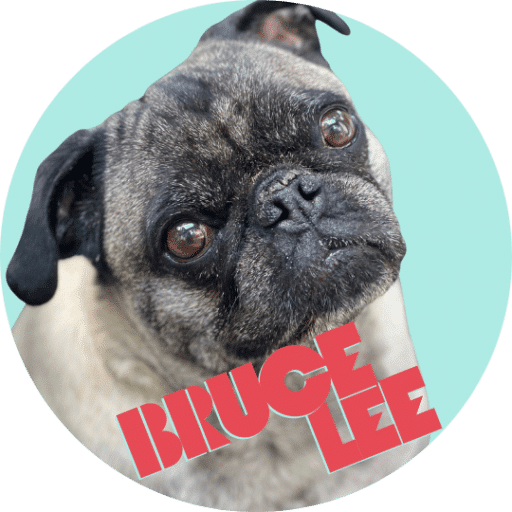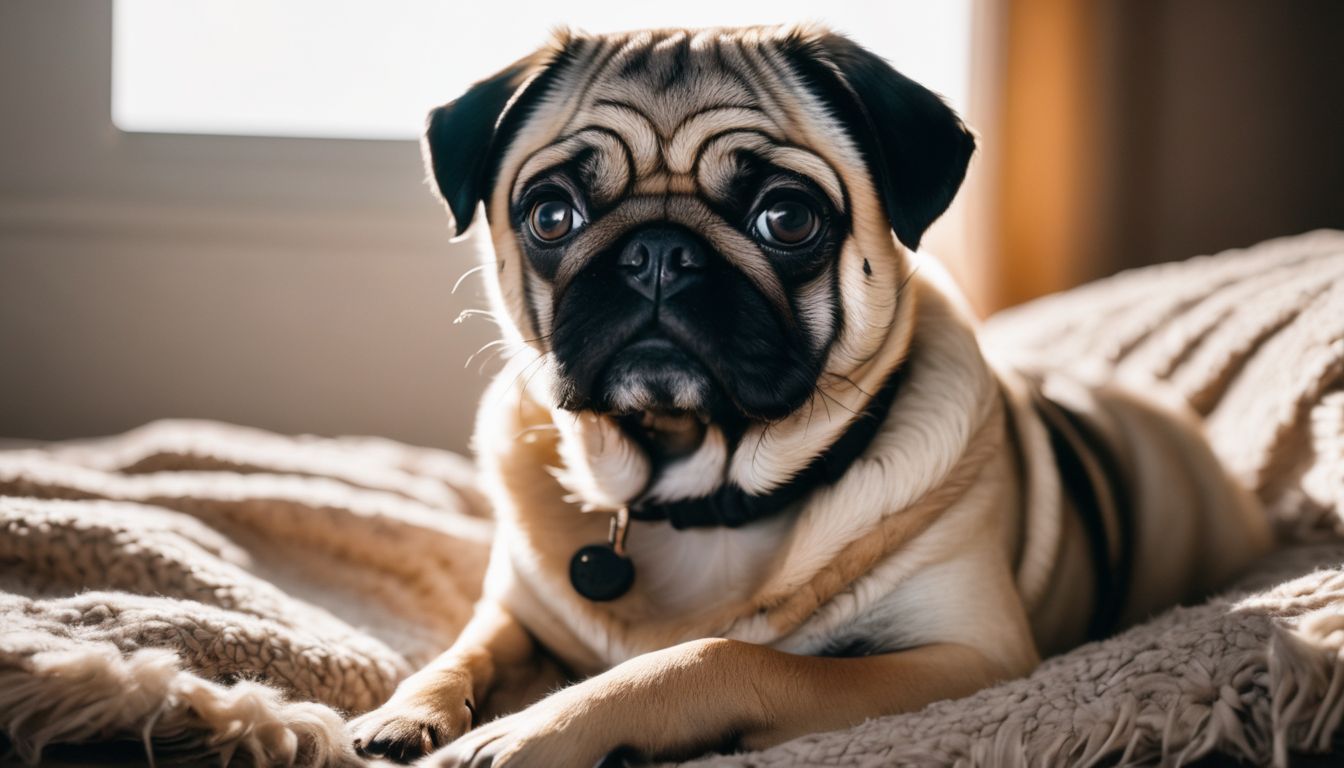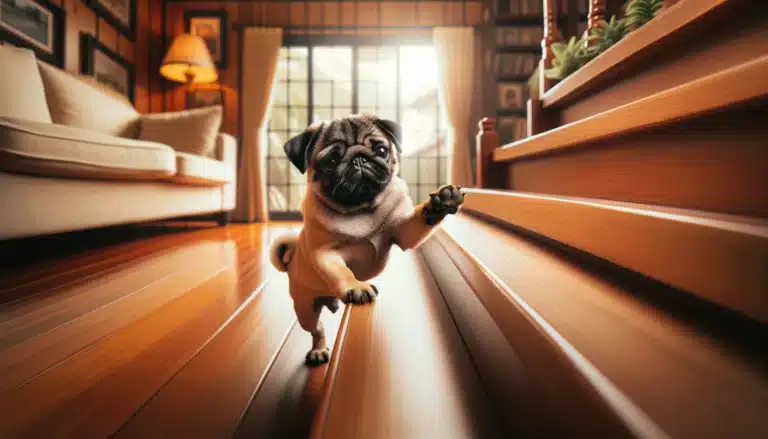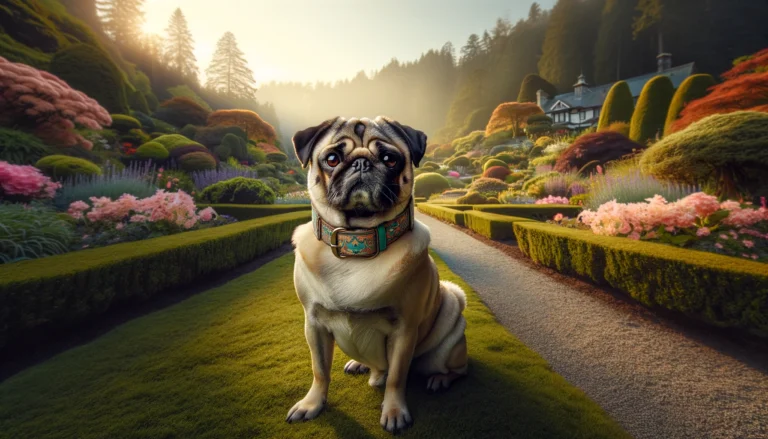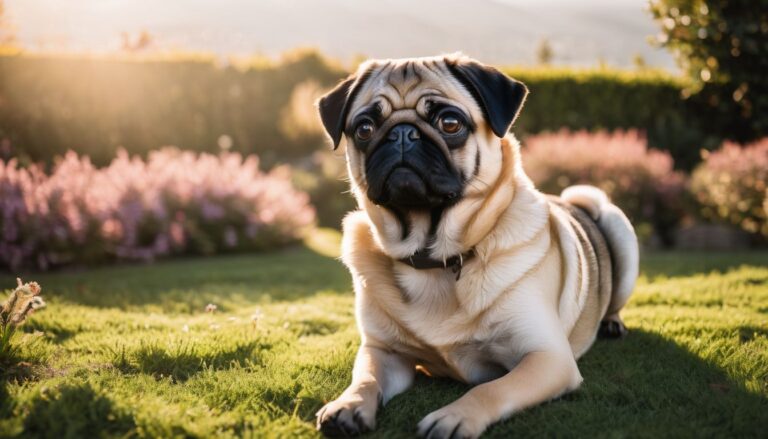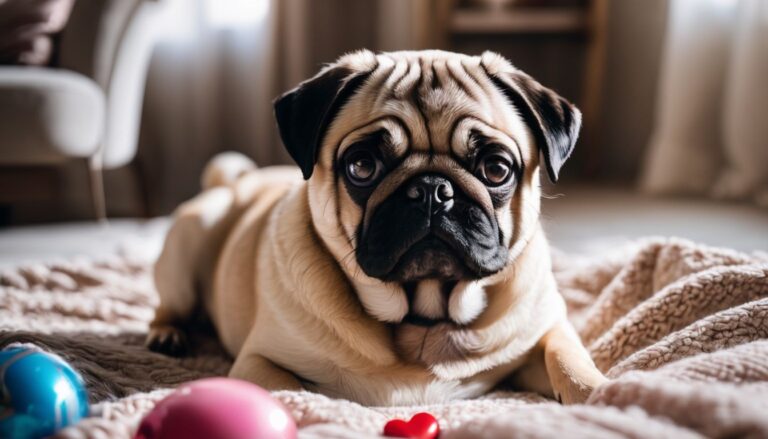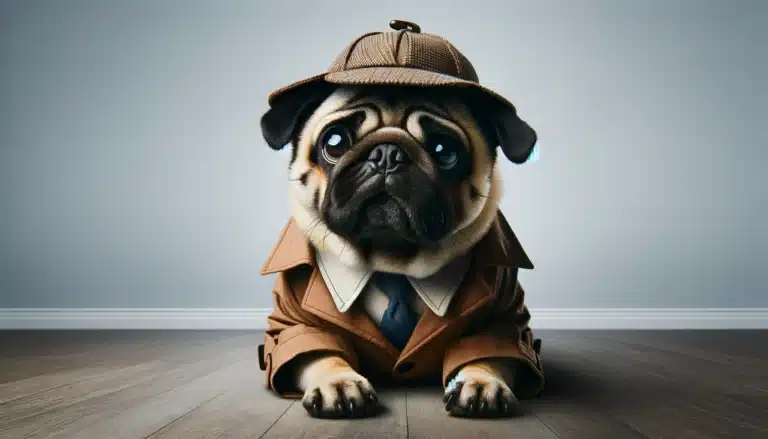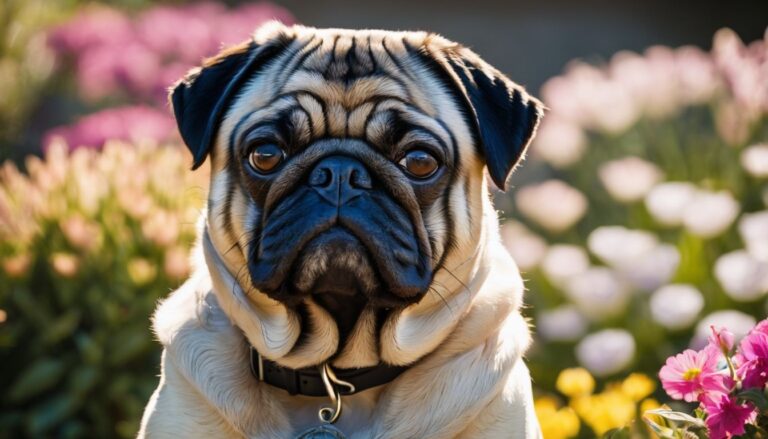Do Pug Dogs Shed? Understanding And Managing Pug Dog Shedding
Do Pug Dogs Shed?
Anyone who’s opened their heart and home to a pug knows that these little bundles of joy have a magical way of leaving a bit of themselves behind—literally! Just like you, we’re absolutely smitten with our squishy-faced friends, despite the constant battle against their hair-raising habit.
Whether they’re nestled cozily on your lap or prancing around the living room, it seems there’s always a furry reminder trailing closely behind them.
We’ve embarked on this journey out of sheer affection for our four-legged companions, determined to get to the bottom of their penchant for shedding. So far, we’ve discovered not just why this endearing breed blankets our homes in fur but also how we can effectively manage this wooly ordeal without letting it dampen the spirit of human-animal kinship.
Stick with us as we share insightful tips and tricks that will help you embrace every fuzzy encounter with grace. This way, you can maintain that loving gaze towards your pug without distraction from the inevitable flurry—a harmonious balance between warm cuddles and keeping those pesky tumbleweeds at bay!
Do pug dogs shed? Yes, yes they do, but we love them regardless.
Key Takeaways
- Pugs shed all year round due to their double coat, consisting of a warm undercoat and protective outer coat. Regular grooming with the right tools can help manage shedding effectively.
- Both black and fawn pugs shed considerably, but the fawn pug’s lighter hair tends to be more visible on surfaces than the darker hair of black pugs.
- Including omega fatty acids in a pug’s diet can improve skin health and potentially reduce excessive shedding from within. Supplements such as fish oil or biotin are also beneficial for maintaining healthy fur.
- Deshedding tools, specialized shampoos, and regular brushing sessions are key strategies in managing pug shedding without resorting to shaving, which can harm their natural coat protection.
- Maintaining cleanliness at home involves frequent vacuuming with HEPA-filtered models that handle pet hair well and using items like lint rollers and furniture covers for quick clean-ups.
Understanding Pug Shedding
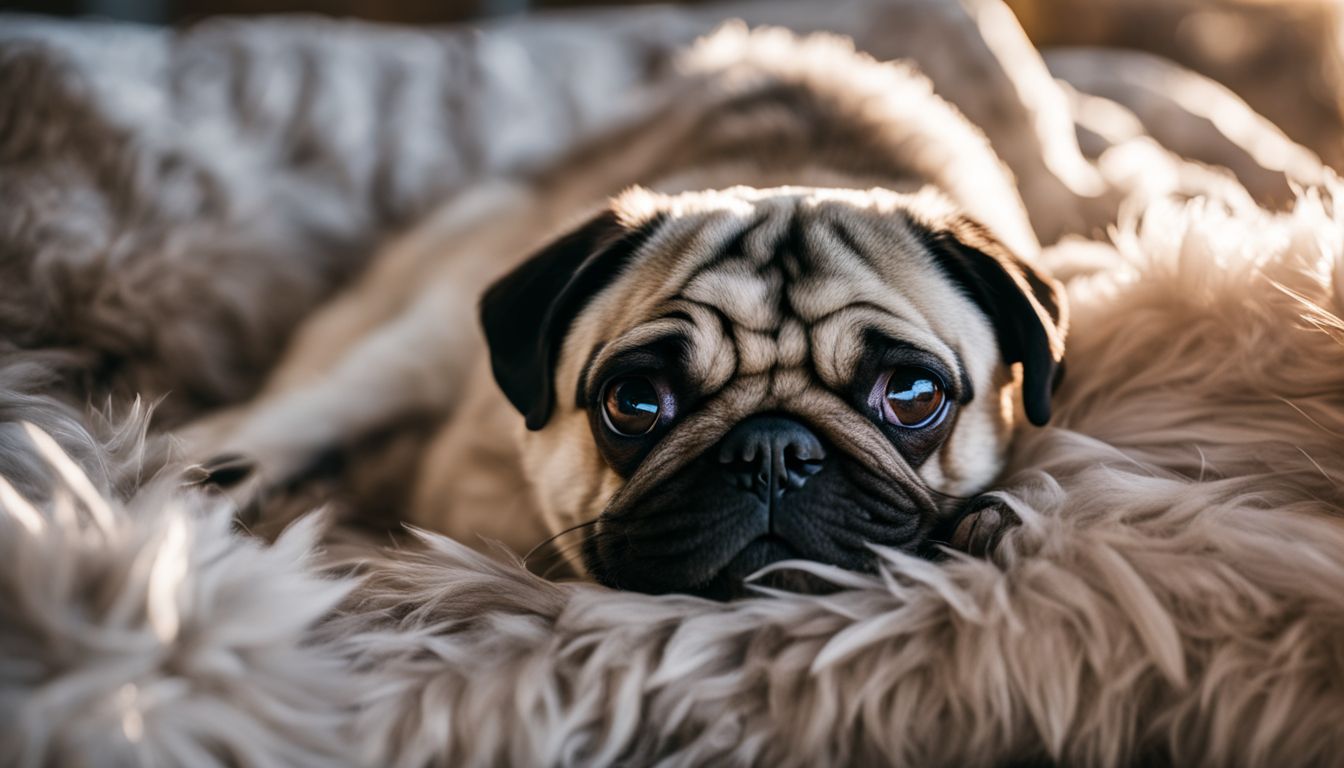
If you’re a proud pug parent, you’ve likely noticed that your cuddly companion leaves behind a furry trail. Let’s dive into the world of pug shedding to uncover why these lovable dogs shed and how their coat color might impact the amount of hair they lose.
Do pug dogs shed?
Absolutely, pugs shed quite a bit. Their charming and adorable appearance comes with a fair amount of fur that tends to find its way onto your clothes, furniture, and floors. The shedding isn’t limited to just a certain time of year; these friendly little companions tend to lose hair all year round.
They possess a distinctive double coat, which means they have two layers of fur: an undercoat that keeps them warm and cozy during cooler seasons, and an outer coat that protects their skin.
Regular grooming can help manage the amount of hair your pug sheds. It’s essential for us as pug owners to stay on top of this task by brushing our dogs routinely—this not only reduces the loose hairs but also distributes natural skin oils throughout their coats, which promotes healthier skin and fur.
Moreover, integrating omega fatty acids into their diet from sources like fish oils can enhance the condition of their coats from the inside out. Investing in good deshedding tools should be part of your routine; it helps remove excess hair before it ends up scattered around your home.
Do black pugs shed more than fawn pugs?
Black pugs often get a reputation for shedding less than their fawn counterparts, but the truth isn’t quite so straightforward. Both colors exhibit significant shedding due to their double coats; it can just be more noticeable with fawn pugs because their lighter hairs stand out against dark clothing and furniture.
Shedding in black pugs might blend in more with various backgrounds or surfaces, giving the illusion they shed less when, in fact, all pug breeds are pretty consistent shedders.
Managing this fur frenzy is part of our regular routine as pug parents. We find that incorporating omega fatty acids into their diet and using deshedding tools can make a big difference.
Now let’s move on to explore whether our beloved pugs shed year-round or if there are certain times we should brace ourselves for an increase in fluffiness around our homes.
Do pugs shed year-round?
Pugs shed throughout the entire year, and as pug enthusiasts, we’ve all experienced a home covered in fur regardless of the season. Their unique double coat with a soft underlayer that keeps them warm and a coarser outer layer contributes significantly to their constant shedding.
Unlike breeds that “blow their coat” at specific times of the year, our little companions liberally sprinkle their hair on furniture, clothes, and floors every day.
We need to stay ahead of this furry challenge by incorporating regular grooming into our routine. Brushing helps collect loose hairs before they end up decorating our homes. Also important is optimizing their diet with dog food rich in omega-3 fatty acids which can improve skin health and potentially reduce shedding intensity.
Keep those vacuum cleaners handy because living with these adorable canines means embracing the fluff they leave behind as part of their undeniable charm.
What triggers pug shedding?
Several factors kickstart pug shedding, and understanding these can help us manage the furry fallout better. Changes in temperature often signal your pet’s body to adjust its coat for comfort – as warmer weather rolls in, you may find more hair than usual around your home because pugs shed heavier to stay cool.
They don’t just shed seasonally either; their shedding is a year-round affair that keeps them from overheating or getting too cold.
Stress, poor diet, and health issues sometimes increase shedding in pugs. We need to keep an eye on our companions’ well-being since something as simple as switching foods or skin irritation might lead to a fluffier living room.
Good nutrition plays a crucial role—it’s not just about keeping their tummies full but also about maintaining a healthy coat with less shedding. Regular check-ups at the vet can catch any underlying conditions early and save our sofas from becoming fur-coated!
Managing Pug Shedding
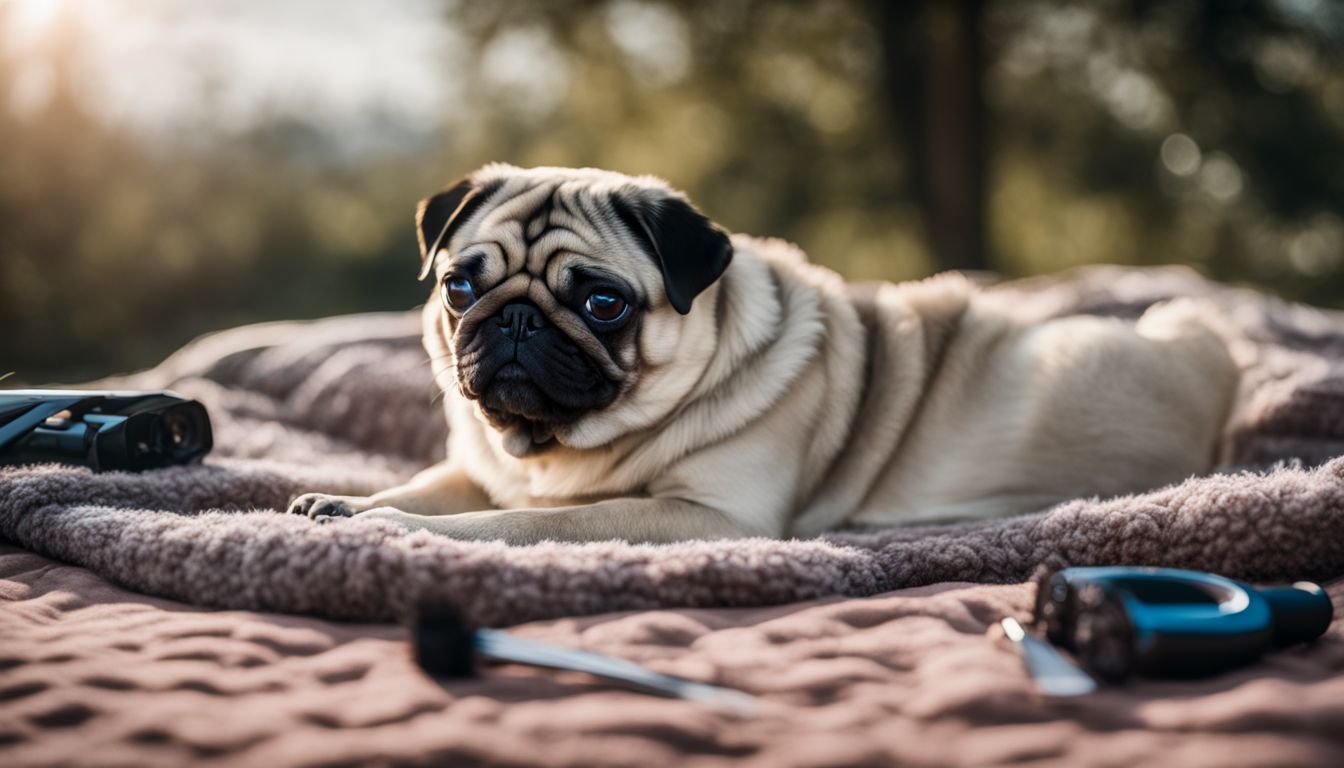
To keep your pug’s shedding under control and maintain their coat’s health, we’ll share effective strategies that go beyond regular brushing. Continue reading to discover these essential tips for a happier home and a shinier pug.
Brushing your pug
Brushing your pug regularly is a vital part of managing their shedding. It helps remove loose hairs and keeps their coat healthy.
- Choose the right brush for your pug’s coat. A brush designed for short-haired breeds works best to get through the double coat without irritating their skin.
- Set a routine to brush your furry friend daily, especially during peak shedding seasons. This will significantly reduce the amount of hair around your home.
- Use gentle strokes to avoid harming their sensitive skin. Pugs are known for having delicate skin underneath that dense fur.
- Incorporate brushing as a bonding activity with your pug. They’ll start associating it with positive attention and affection, making it an enjoyable experience for both of you.
- Focus on areas where shedding is most prominent, like behind the ears and beneath the legs. These spots can harbor more loose hair due to friction.
- Dispose of collected fur properly. Secure it in a bag before discarding it to prevent stray hairs from floating back into the room.
- Explore deshedding tools that can handle their double-coated fur more effectively than standard brushes, reducing the overall volume of shed hair.
- Reward your pug after each brushing session. A little treat or extra cuddle time encourages good behavior and makes future sessions easier.
- If you’re uncertain about techniques or tools, seek advice from professional groomers who are well-versed in caring for a pug’s specific needs.
Incorporating omega fatty acids into their diet
We understand that managing pug shedding can be a challenge, but adding omega fatty acids to their diet is a smart move. These essential nutrients, which include both eicosapentaenoic acid (EPA) and docosahexaenoic acid (DHA), support skin health and promote a shiny coat.
They work from the inside out, nourishing your pug’s skin and potentially reducing excessive shedding.
Feeding our pugs foods rich in omega-3s or providing supplements specifically designed for dogs can make a noticeable difference. Your vet might recommend fish oil capsules or a liquid supplement that you can mix into your pug’s food.
Keep an eye on the improvement in fur texture and shine – it’s usually an indication that those omega fatty acids are doing their job!
Using deshedding tools and products
Deshedding tools and products are essential for managing pug shedding effectively. As pug lovers, we want to keep our companions comfortable and our homes clean.
- Consider using deshedding shampoos during bath time. These shampoos help loosen dead fur and make brushing more effective afterward.
- Invest in a high-quality vacuum with a HEPA filter. It’s crucial to frequently clean your home to remove the pug hair that escapes despite brushing.
- Try out deshedding wipes or sprays. They’re handy for quick touch-ups between grooming sessions to collect loose fur.
- Keep your pug hydrated. Providing plenty of water helps maintain healthy skin and fur, reducing excessive shedding.
- Incorporate omega 3 supplements into their diet, as these can promote healthier skin and coat, leading to less shedding over time.
Tips for Minimizing Pug Hair Around the House
Maintaining a pug-friendly household doesn’t have to mean living with hair everywhere. We’ve gathered some smart strategies to significantly reduce the presence of pug fur in your home, ensuring it stays clean and comfortable for everyone.
Regular grooming
Regular grooming plays a crucial role in managing the shedding of our pug dogs. It helps keep their coat healthy and reduces the amount of hair that ends up on our furniture and clothes.
- Make sure to dry their coat thoroughly after washing. Use a low-heat setting on your blow dryer to avoid damaging their skin.
- Check your pug regularly for signs of skin issues that can increase shedding, such as dry patches or irritation. If you notice anything unusual, consult with veterinarians promptly.
- Reward your pug with treats during grooming sessions so they associate this time with positive experiences.
- Pay extra attention to areas where shedding is typically heavier. Pugs often lose more hair around their necks and on their chests.
- Keep an eye on your pug’s diet because adding omega fatty acids can promote healthier skin and fur, leading to less shedding over time.
Controlling pug hair with a good vacuum
Investing in a high-quality vacuum can make a big difference in your battle against pug hair. Look for models designed to handle pet fur; these often come with specialized attachments that lift hair from carpets and furniture effortlessly.
We recommend vacuums with strong suction power and HEPA filters to trap allergens, keeping your home not only clean but also healthy.
Make it a habit to vacuum frequently during shedding season, as this is when your pug blows their coat the most. Quick passes over high-traffic areas daily can prevent buildup, while a more thorough cleaning once or twice a week can maintain a fur-free environment.
With consistent use of an effective vacuum cleaner, tackling the challenge of persistent pug shedding becomes much easier.
Other handy items to have around the house
Keeping your home free from pug hair takes a few additional tools. We’ve found that having these items on hand makes managing our shedding friends a lot easier.
- Lint rollers: These are fantastic for quick touch-ups on clothes and furniture. Just roll it over the surface, and it picks up loose hairs in seconds.
- Furniture covers: Protect sofas and chairs with washable covers. They catch the fur, which you can then easily shake out or launder.
- Microfiber dust mops: These mops trap and hold dog hair when you sweep your floors, keeping dust and pet dander in check.
- Air purifiers: These help to reduce airborne pet hair and dander, keeping your breathing space cleaner.
- Grooming gloves: Slip them on to pet your pug while gently removing loose fur. It’s like giving them a massage that also cleans!
- Sticky tape: It’s perfect for getting hair off of less accessible spots where lint rollers might not reach.
- Robotic vacuums: Set them to run daily to constantly keep hair off your floors – they can be real time-savers.
- Specialty pet beds: Choose ones with removable, easy-to-wash covers to contain hair in one spot rather than all over the house.
Shaving Your Pug: Is it a good idea?
Many pug owners may wonder if shaving their cuddly companion is beneficial for reducing shedding, but before reaching for the clippers, it’s crucial to understand the potential impacts on your pug’s health.
Let’s dive into whether this common grooming technique should be a part of your pug care routine.
Possible negative effects
Shaving your pug may seem like a quick fix to manage shedding, but it can actually do more harm than good. Their double-coated fur acts as insulation against both cold and heat, so when you shave them, they lose this natural protection.
This leaves their skin vulnerable to sunburns and temperature extremes. Without their outer coat, pugs also risk damaging the regrowth of hair, which could lead to uneven patches or a change in texture.
Exposing your pug’s skin can invite a host of issues such as allergies or infections since their fur serves as a barrier against environmental irritants. Regular grooming is essential; however, shaving down to the skin disrupts the normal shedding process and isn’t recommended by veterinary professionals.
We have to consider these potential health risks seriously before deciding on shaving our furry companions.
Alternatives to shaving
Shaving your pug might seem like a quick fix to reduce shedding, but it can harm their skin and coat. Instead, let’s explore safer options that keep your pug comfortable and minimize hair loss.
- Engage in regular brushing sessions using a bristle or rubber brush that’s gentle on your pug’s skin while effectively removing loose hair.
- Invest in high – quality deshedding tools that reach the undercoat without damaging the topcoat or irritating the skin.
- Provide a balanced diet rich in omega fatty acids which strengthens hair follicles and reduces excessive shedding from within.
- Ensure your pug stays hydrated; sufficient water intake helps maintain healthy skin and fur.
- Baths with moisturizing dog shampoos can help loosen dead hairs and keep the coat healthy but don’t overdo it as this could dry out their skin.
- Consider using specially formulated sprays that strengthen the coat and reduce static, making it easier to remove loose hairs during grooming.
- Maintain consistent flea control since infestations can lead to increased scratching and hence more shedding.
Black Pugs vs Fawn Pugs: Who Sheds More?
When we, the devoted pug lovers, dive into the realm of pug coats, it’s crucial to understand the nuances between black and fawn pugs in terms of shedding. We’ve done our homework, so let’s lay out the facts.
| Aspect | Black Pugs | Fawn Pugs |
|---|---|---|
| Shedding Level | Considered to shed less visibly | Often shed more noticeably |
| Coat Type | More visible due to the lighter color | Usually have a double coat |
| Visibility of Shed Hair | Less visible on dark surfaces | More visible due to lighter color |
| Seasonal Shedding | May appear less due to consistent coat color | Seasonal shedding is more pronounced |
Fawn pugs often come with a double coat, which includes a soft underlayer that sheds throughout the year, especially during the shedding season. Black pugs, while still shedders, typically have a single coat that doesn’t leave as much visible hair around. This difference doesn’t imply that black pugs shed any less than their fawn counterparts; the dark hairs they lose are just not as noticeable. Regardless of color, we pug enthusiasts embrace our furry friends, knowing that managing their shedding is part of the joy of sharing our lives with these charming canines.
Do Pug Dogs Shed Conclusion
We’ve explored the puffy world of pug shedding, unraveling why these cuddly canines leave their mark on our homes and hearts. Embrace the fur frenzy with smart grooming habits that tame their tufts.
Remember, every strand tells a tale of your furry friend’s presence and unconditional love. Cherish each moment—fluff and all—as you manage your pug’s coat with care! Keep your home clean and your bond with your pug unbreakable by staying one step ahead in the shedding game.
Do Pug Dogs Shed FAQs
1. How can I reduce excessive fur loss?
To tackle excessive fur loss in our pugs, we make sure to keep a consistent grooming routine. Regular brushing is key; it not only removes loose hair before it can drop off on its own, but also helps distribute natural skin oils that keep their coat healthy and reduce shedding.
Investing in a high-quality brush suited for a pug’s unique double coat works wonders.
We also focus on their diet by incorporating omega fatty acids, which strengthen the hair follicles and promote a glossy coat. A balanced diet rich in these nutrients can help minimize shedding from the inside out.
And don’t overlook deshedding tools or specially formulated shampoos that are designed to manage excess hair loss; they provide an extra hand during peak shedding seasons.
2. Are there any supplements that can help manage pug shedding?
Absolutely, there are supplements that can be game-changers in managing our pugs’ shedding. Omega-3 fatty acids, for instance, promote healthier skin and a shinier coat which can reduce the amount of loose fur.
Fish oil supplements are an excellent source of these omega-3s and we’ve seen great results when they’re added to regular meals.
Biotin is another supplement that supports good coat health. Including this B-vitamin in your pug’s diet could strengthen their hair follicles, potentially leading to less shedding around the house.
It’s important to consult with a vet before starting any new supplement regimen though; they’ll help us determine the right dosage for our furry friends based on size and specific needs.
3. Do pug dogs shed a lot compared to other breeds?
Yes, shedding pugs can lose quite a bit of fur because they are double-coated breeds. Unlike the Yorkshire Terrier, which is known for light shedding, pugs tend to shed more throughout the year.
4. Can anything be done to manage my pug’s shedding?
To manage your pug dog’s shedding effectively, regularly brushing their coat will help remove loose hairs and keep their skin healthy. You could also use tools like the Dyson DC54 vacuum to clean up after your furry friend.
5. Are there any health issues related to pugs and their shedding?
Pug dogs might experience excessive shedding due to health conditions such as Alopecia X; this requires veterinary attention. Also, since some have lighter fur or even albinism, protect them from getting sunburned as it can affect their skin and cause further hair loss.
6. Is it true that no dogs are completely hypoallergenic even if they don’t shed much?
That’s correct! No breed is entirely hypoallergenic including those that don’t shed much or at all like Albino Pugs who may still produce dander that causes allergies in humans.
